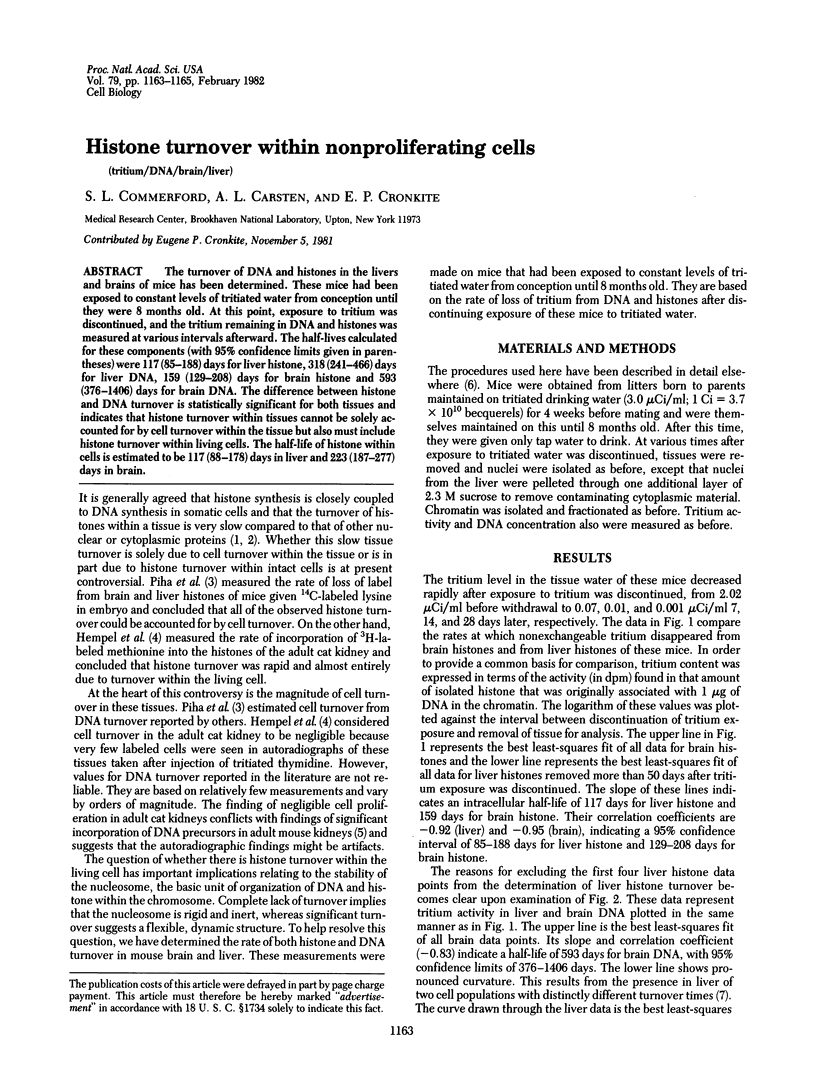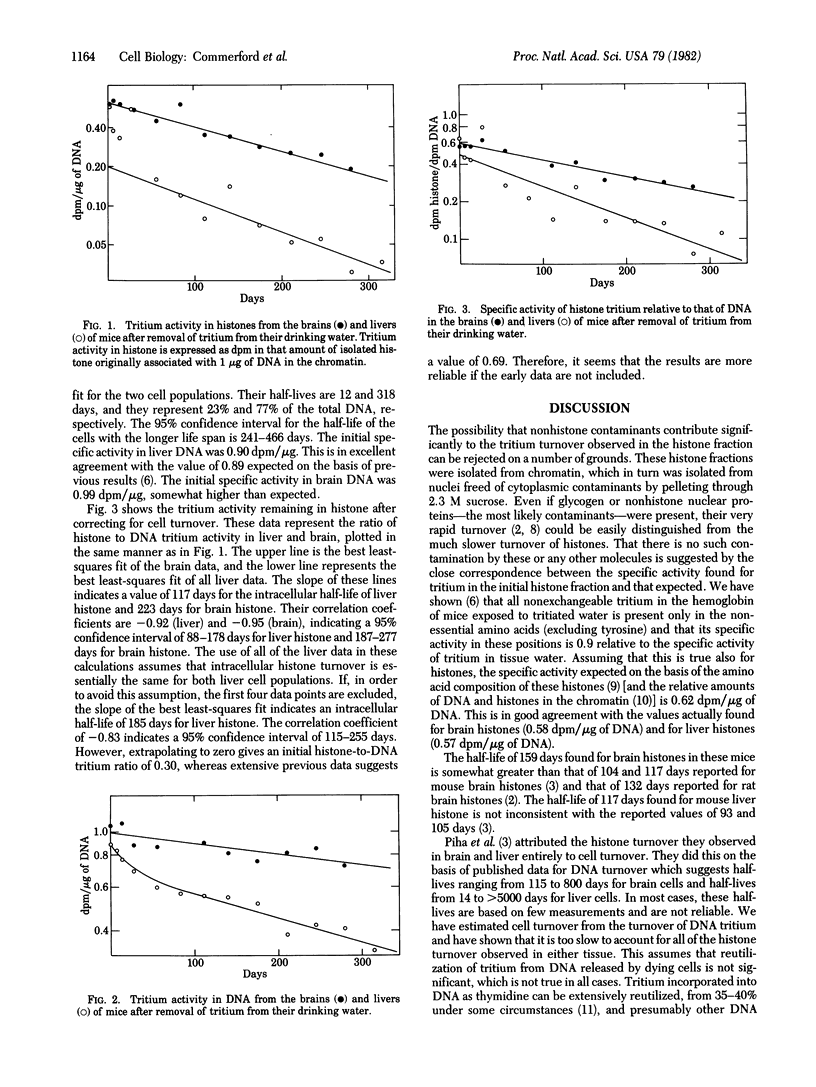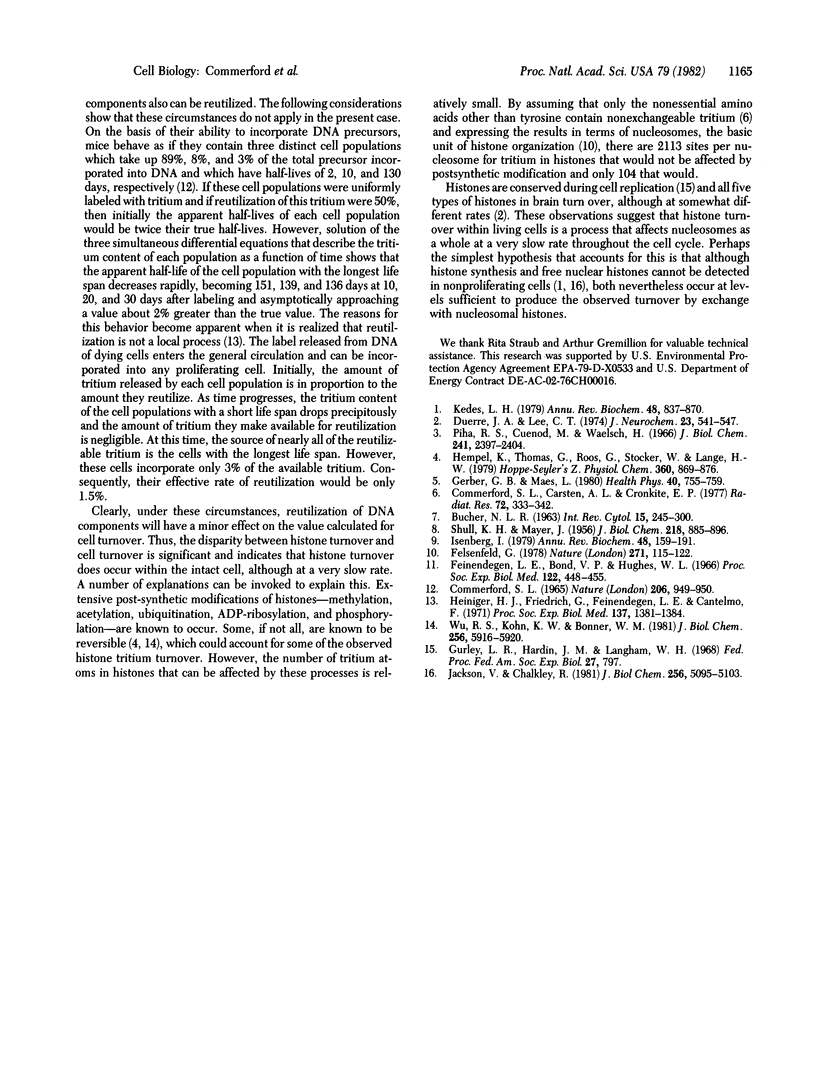Abstract
The turnover of DNA and histones in the livers and brains of mice has been determined. These mice had been exposed to constant levels of tritiated water from conception until they were 8 months old. At this point, exposure to tritium was discontinued, and the tritium remaining in DNA and histones was measured at various intervals afterward. The half-lives calculated for these components (with 95% confidence limits given in parentheses) were 117 (85-188) days for liver histone, 318 (241-466) days for liver DNA, 159 (129-208) days for brain histone and 593 (376-1406) days for brain DNA. The difference between histone and DNA turnover is statistically significant for both tissues and indicates that histone turnover within tissues cannot be solely accounted for by cell turnover within the tissue but also must include histone turnover within living cells. The half-life of histone within cells is estimated to be 117 (88-178) days in liver and 223 (187-277) days in brain.
Keywords: tritium, DNA, brain, liver
Full text
PDF


Selected References
These references are in PubMed. This may not be the complete list of references from this article.
- BUCHER N. L. REGENERATION OF MAMMALIAN LIVER. Int Rev Cytol. 1963;15:245–300. doi: 10.1016/s0074-7696(08)61119-5. [DOI] [PubMed] [Google Scholar]
- Commerford S. L. Biological stability of 5-iodo-2'-deoxyuridine labelled with iodine-125 after its incorporation into the deoxyribonucleic acid of the mouse. Nature. 1965 May 29;206(987):949–950. doi: 10.1038/206949a0. [DOI] [PubMed] [Google Scholar]
- Commerford S. L., Carsten A. L., Cronkite E. P. The distribution of tritium in the glycogen, hemoglobin, and chromatin of mice receiving tritium in their drinking water. Radiat Res. 1977 Nov;72(2):333–342. [PubMed] [Google Scholar]
- Duerre J. A., Lee C. T. In vivo methylation and turnover of rat brain histones. J Neurochem. 1974 Sep;23(3):541–547. doi: 10.1111/j.1471-4159.1974.tb06057.x. [DOI] [PubMed] [Google Scholar]
- Feinendegen L. E., Bond V. P., Hughes W. L. Physiological thymidine reutilization in rat bone marrow. Proc Soc Exp Biol Med. 1966 Jun;122(2):448–455. doi: 10.3181/00379727-122-31159. [DOI] [PubMed] [Google Scholar]
- Felsenfeld G. Chromatin. Nature. 1978 Jan 12;271(5641):115–122. doi: 10.1038/271115a0. [DOI] [PubMed] [Google Scholar]
- Gerber G. B., Maes J. Incorporation and turnover of tritium in neonatal mice and their mothers after feeding tritiated thymidine during pregnancy. Health Phys. 1981 May;40(5):755–759. [PubMed] [Google Scholar]
- Heiniger H. J., Friedrich G., Feinendegen L. E., Cantelmo F. Reutilization of 5- 125 I-iodo-2'-deoxyuridine and 3 H-thymidine in regenerating liver of mice. Proc Soc Exp Biol Med. 1971 Sep;137(4):1381–1384. doi: 10.3181/00379727-137-35793. [DOI] [PubMed] [Google Scholar]
- Hempel K., Thomas G., Roos G., Stöcker W., Lange H. W. N epsilon-Methyl groups on the lysine residues in histones turn over independently of the polypeptide backbone. Hoppe Seylers Z Physiol Chem. 1979 Jul;360(7):869–876. doi: 10.1515/bchm2.1979.360.2.869. [DOI] [PubMed] [Google Scholar]
- Isenberg I. Histones. Annu Rev Biochem. 1979;48:159–191. doi: 10.1146/annurev.bi.48.070179.001111. [DOI] [PubMed] [Google Scholar]
- Jackson V., Chalkley R. A reevaluation of new histone deposition on replicating chromatin. J Biol Chem. 1981 May 25;256(10):5095–5103. [PubMed] [Google Scholar]
- Kedes L. H. Histone genes and histone messengers. Annu Rev Biochem. 1979;48:837–870. doi: 10.1146/annurev.bi.48.070179.004201. [DOI] [PubMed] [Google Scholar]
- Piha R. S., Cuénod M., Waelsch H. Metabolism of histones of brain and liver. J Biol Chem. 1966 May 25;241(10):2397–2404. [PubMed] [Google Scholar]
- SHULL K. H., MAYER J. The turnover of liver glycogen in obese hyperglycemic mice. J Biol Chem. 1956 Feb;218(2):885–896. [PubMed] [Google Scholar]
- Wu R. S., Kohn K. W., Bonner W. M. Metabolism of ubiquitinated histones. J Biol Chem. 1981 Jun 10;256(11):5916–5920. [PubMed] [Google Scholar]


